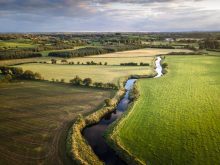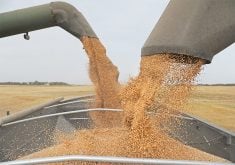SARM delegates overwhelmingly approve resolution rejecting ‘any policies that unduly target naturally occurring CO2’
REGINA — It’s unclear exactly what rural municipal delegates meant when they overwhelmingly passed a resolution about carbon dioxide last week at their annual convention.
The resolution, submitted by the Rural Municipality of Tullymet on behalf of 30 RMs, called on the Saskatchewan Association of Rural Municipalities to “ensure that any policies that unduly target naturally occurring C02 will be deemed as illogical and dangerous. We move that Saskatchewan remove itself from any national or international agreements that reference net zero.”
Ninety-five percent of delegates agreed.
Read Also

Canola oil transloading facility opens
DP World just opened its new canola oil transload facility at the Port of Vancouver. It can ship one million tonnes of the commodity per year.
Councillor Jay Dixon, who moved the motion, said carbon dioxide is essential for photosynthesis and, subsequently, life.
“For the creation of net zero emissions, C02 is being attacked,” he said during debate.
“The policies that need to be implemented to achieve net zero have proven to be both ineffective and financially destructive to our industry.”
He did not reply before The Western Producer deadline to a request for more information on which policies those are and which ones target the natural carbon cycle.
Al Magel, reeve of the RM of Last Mountain Valley, spoke in favour of the resolution. He said that many of the predicted climate change calamities, such as rising sea levels due to melting ice, have not come to pass.
“Al Gore’s movie The Inconvenient Truth should have been renamed The Inconvenient Lie,” he said.
“Before that it was the ozone layer will be destroyed in 10 years. Before that, it was the ice age. Before that it was acid rain. What did we do about it? Nothing, and nothing happened.”
Global estimates suggest sea levels have risen between 21 and 24 centimetres since 1880, and the United States predicts waters along its coastline will rise another 25 to 30 cm between 2020 and 2050. Stronger air pollution regulations have both reduced the impact of acid rain and allowed the hole in the ozone layer to begin to repair.
Magel said the science is not settled and it’s arrogant to suggest humans can predict the weather or climate. He said Greenpeace founder Patrick Moore has said carbon dioxide is not a pollutant.
“So before we target the production of food and manufacturing of crop nutrition with net zero policies, the policy makers should ban the use of private jets or carbonated drinks and those horrible greenhouse operations that pump C02 into their greenhouses,” he said.
That prompted RM of Piapot reeve John Wagner to observe employees don’t stagger out of greenhouses to get air.
Kerri Finlay, a biology professor at the University of Regina and co-director of the Institute for Environmental Change and Society, said the issue is far more complex than the resolution suggests.
“Yes, C02 is naturally occurring and used by plants, but human activities are moving massive amounts of C02 in the atmosphere, causing climate change,” she said.
“The dose makes the poison. A comparable argument would be that nitrogen and phosphorus are also required for plant growth, but when we over-fertilize, the excess runs off into lakes causing harmful algal blooms and toxic blue-green algae growth.”
She said a pollutant is defined as a substance introduced into an environment that produces undesirable effects and can be naturally occurring or human-made.
Finlay added that carbon dioxide is only one of three gases of concern. The other two are methane and nitrous oxide.
“When we talk about net zero, we are not only discussing C02 but all three of these summed up as C02 equivalents. So to note only that C02 is required by plants is disingenuously ignoring the other greenhouses gases as well,” she said.
University of Saskatchewan researcher Ryan Brook said scientists agree that the Earth needs carbon dioxide, but also that it is the most important greenhouse gas because it accounts for about three-quarters of emissions caused by humans.
“However, while C02 is naturally occurring and very useful, just like many other natural substances, it is a pollutant at excessive levels,” he said.
In the last 50 years the concentration in the Earth’s atmosphere has risen from 330 parts per million to 420 p.p.m.
“Some experts have said that we must stay below 350 for the Earth to be sustainable,” Brook said.
He said SARM delegates are correct to say that C02 occurs naturally, but the missing piece is “at appropriate levels.”
Humans continue to add tonnes into the atmosphere each year, resulting in short-term benefits such as crop production and longer growing seasons but also the major risks of extreme weather events, changing water availability, crop loss due to rising temperatures and likely disease outbreaks, Brook said.
Much of the rural discontent stems from the federal carbon tax, which will rise from $65 per tonne to $80 per tonne on April 1. However, that tax targets burning of fossil fuels, not natural cycles.
Provincial environment minister Christine Tell was unavailable for an interview but in a statement said Saskatchewan is focusing on reducing greenhouse gas emissions without a punitive carbon tax. The province has a methane action plan to reduce emissions from venting and flaring in the upstream oil and gas industry. It also has a plan to be net zero from electricity by 2050.
















